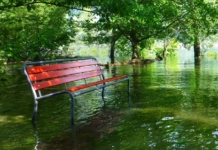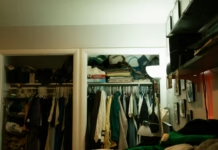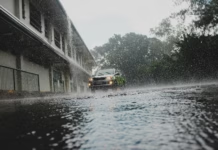As drought warnings grow, research reveals the UK cities expected face the most water stress by 2040
- As the UK prepares for a very dry August, with warnings around drought and hosepipe bans, new research by Sanctuary Bathrooms reveals which areas of the UK are expected to experience the most water stress by 2040
- Lancaster could be set to see the worst water shortages in the UK as its water stress levels are predicted to increase over 80% by 2040
- Experts at Sanctuary Bathrooms share five easy ways to reduce water usage in the bathroom
Following record-breaking high temperatures in July, the UK is now heading into a very dry August with drought warnings from authorities, and hosepipe bans proposed by water firms.
With daily water consumption rising, and the average person using 142 litres daily[1], as well as warnings from the National Infrastructure Committee (NIC) about the failure to act now on water2, new research by Sanctuary Bathrooms uncovers which areas across the UK and Europe, are expected to experience the highest levels of water stress over the next 20 years.
To combat this, the company has highlighted five easy ways for Brits to dramatically reduce their own water usage, at home, in what can often be the most water-intensive room of the house – the bathroom!
Lancaster will be the worst city for water shortages in the UK
By 2040, Lancaster is forecasted to see an ‘extremely high’ increase (80%) in its water stress levels, meaning that residents of the city could see a serious public water supply drought.
After Lancaster, London, Brighton and Hove and Leicester are all set to see ‘high’ (40-80%) increases in water stress levels. Residents in the South and South East of England are more likely to experience a dramatic increase in their water stress levels, due to existing and growing population density, along with associated requirements for housing and property developments. This is as well as changing climate conditions and less rainfall than other areas of the UK.
According to the South East River trust, by 2050, the South East of England will need to find at least an additional one billion litres of water per day to meet demand in the region3.
Predicted water stress increase for UK cities by 2040
| City | Estimated increase in water stress by 2040 |
| Lancaster | Extremely high (>80%) |
| Northampton | High (40-80%) |
| Peterborough | High (40-80%) |
| Bedford | High (40-80%) |
| Cambridge | High (40-80%) |
| Ely | High (40-80%) |
| London | High (40-80%) |
| Brighton & Hove | High (40-80%) |
| Birmingham | High (40-80%) |
| Leicester | High (40-80%) |
| Manchester | Medium-high (20-40%) |
| Edinburgh | Medium-high (20-40%) |
| Liverpool | Medium-high (20-40%) |
| Glasgow | Low-medium (10-20%) |
| Leeds | Low-medium (10-20%) |
| Sheffield | Low-medium (10-20%) |
| Cardiff | Low-medium (10-20%) |
| Newcastle Upon Tyne | Low (<10%) |
| Belfast | Low (<10%) |
Major UK cities like Manchester, Edinburgh, Liverpool, and Bristol are all predicted to see ‘medium-high’ increases in stress levels by 2040 (20-40%). Whereas Leeds, Glasgow, Sheffield, and Cardiff are predicted to have lower estimated water stress than other UK cities in the next 20 years (10-20 %).
Five easy things Brits can do now, to use less water in their bathrooms
1. Stop leaks or upgrade brassware like shower heads and taps:
Leaky taps and shower heads could mean you are wasting water each day without even knowing it. Changing shower heads and faucets can save up to 40% or 55% respectively.
Leaky brassware may not seem a big issue in the grand scheme but the constant drip-dripping but the water usage can soon tick up. While you may rush to find new brassware, it could be as quick as giving them a good cleaning. Bathroom taps, for instance, can have ceramic discs or washers that get clogged or dirty and need a quick clean out. Giving your brassware proper care and attention can help save water and even the expense of new bathroom items.
If you decide to upgrade then newer designs have “air pressurized in the water” to help give the impression of a more powerful shower without damaging the experience.
As well as this, upgrading your shower head to a low-flow version with high pressure can help. The benefits of this mean not compromising your existing shower, while saving water usage and saving money.
2. Stop flushing unnecessary items down the toilet:
Of course, when you go to the toilet, flushing is necessary. But often, you might use toilet paper to blow your nose while in the bathroom, and flush it down the toilet afterwards, instead of venturing to the bin and throwing it away. Without thinking about it, you’re then wasting water on something that could’ve been disposed of elsewhere, particularly if you’re using a dual flush system and pressing the ‘full flush’ button to get rid of whatever it is. Being more mindful of what you flush, and how you flush, can make a small difference.
3. Take shorter Showers:
A long hot shower may be just what you need to clear away the cobwebs on a morning but cutting your shower time even by a small amount of time can make a big difference. Did you know that you use 2.5 gallons of water per minute when you shower? This doesn’t just stop at using the shower, but also extends to avoiding turning the shower on and leaving it to get warm while doing other things, or using it when cleaning instead of re-using water and cleaning products used across other bathroom areas.
4. Turn off your taps when you can:
It may seem obvious, but turning off your taps when you brush your teeth, while you’re washing or shaving your face, or even when you’re cleaning the sink can use a lot more water than you realise. In fact, it’s one of the biggest water wasters, so turning these off while doing household or beauty tasks can instantly help make a small difference.
5. Showers vs Baths:
Doing your part to save water in the bathroom could be the difference between hopping in the shower or jumping in the bathtub. We know that luxury means being able to sink into a hot bath and while the time away. However, changing from baths to showers, whether standalone, over your tub, or a handset alongside your bath, significantly reduces your water usage. A full bath uses an average of 80 litres of water compared to an electric shower which uses just 5 litres per minute.
A two or three minute shower will use a lot less water than a bath – especially if you turn the water off while you shampoo. A 20-minute shower will not – so aim for short showers.
To see more info on the future water scarcity in the UK and Europe, along with more ways to reduce your water usage visit: https://www.sanctuary-bathrooms.co.uk/blog/water-scarcity-the-worst-places-for-water-shortages-over-the-next-20-years/
Commenting on the findings, James Roberts, Director at Sanctuary Bathrooms said: “These shocking findings illustrate that the UK could be facing a huge problem with water availability across areas of the country in the coming decades, and our collective usage is going to have a direct impact on future generations to come.
“Our bathroom habits contribute to this, since maintaining good hygiene uses water in most activities, if not all, as part of our daily rituals. But this is something that extends to other areas of the home, and even our workplaces too. It is vital we raise awareness by highlighting key figures and stats – for example, not many people know that a bath uses 80 litres of water in one go!
“Brits are understandably becoming more aware of their eco footprint, and impact on the climate and environment around them, and we are seeing more people focusing on this and looking to shop more savvy and greener for their bathroom. There are small changes that everyone can make to help reduce their personal impact and tackle this issue, whether that is switching water off in-between activities, regular cleaning and maintenance of taps and showers, and even switching baths for short showers.”

| [donate]
| Help keep news FREE for our readersSupporting your local community newspaper/online news outlet is crucial now more than ever. If you believe in independent journalism,then consider making a valuable contribution by making a one-time or monthly donation. We operate in rural areas where providing unbiased news can be challenging. |



















